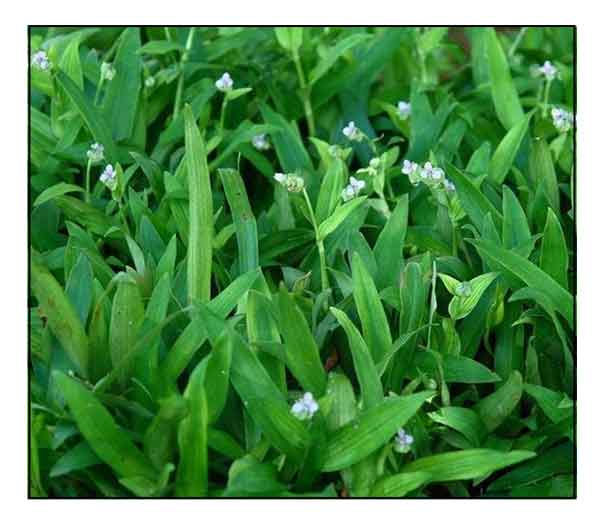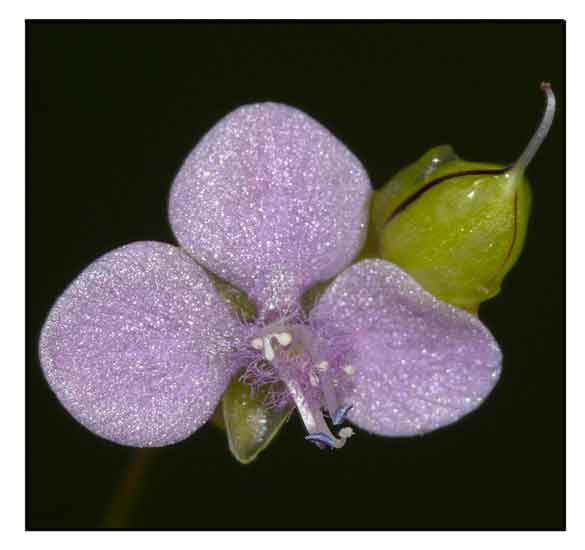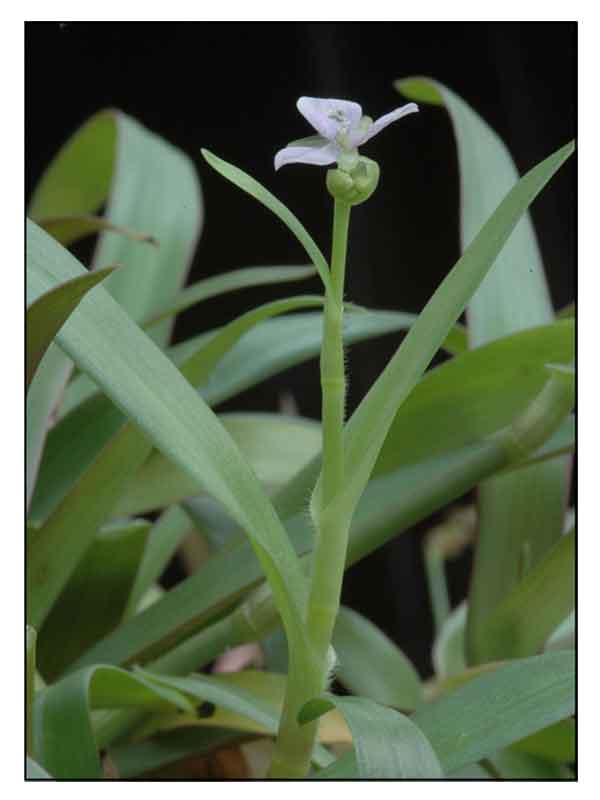 Gen info Gen info
- Murdannia is a genus of annual or perennial monocotyledonous flowering plants in the family Commelinaceae. The genus is one of the largest in the family. It is distinguished from other genera in the family by their three-lobed or spear-shaped antherodes (non-
functional anthers). It is the only genus with staminodes (non-functional stamens) opposite the petals. (2)
- The genus is named in honor of Murdan Ali, a plant collector who worked for John Forbes Royle and maintained the herbarium at Saharunpore, India.
He was a munshi who became a proficient botanist who compiled a never-published vernacular flora of northern India and the Himalayas. (2)
 Botany Botany
M. loriformis is a monocotyledonous and perennial herb. It is approximately 10 cm tall. The basal leaves of M. loriformis are simple, blades linear, alternate, and glabrous. The main stem is undeveloped; fertile stems are numerous, arising from the rosette, diffuse or ascending, measure 15–50 cm, glabrous or puberulent on one side, extremely rarely densely hirsute. The basal leaves with a linear blades measure 5–15 cm long and 6–9 mm wide. The flowers are terminal, inflorescence and densely panicle. The involucral bracts are leaflike but smaller than leaves, distal ones extremely small, less than 10 mm, and peduncle about 2.5 cm. Pedicels slightly curved, translucent bracts about 4 mm, sepal, ovate-elliptic, about 3 mm, herbaceous. The petals are blue or bluish violet and obovate orbicular. The capsule is ovoid globose and trigonous, about 3–4 mm. The seeds have two per valve: yellow-brown, radiate, striate, and finely white reticulate. The rhizomes are absent. The roots are fibrous that measures approximately 0.5–1 mm in diameter, glabrous or tomentose. (2)
Distribution
- Native to the Philippines.
- Also native to Assam, Bangladesh, China, Hainan, India, Japan, Jawa, Nansei-shoto, New Guinea, Ogasawara-shoto, Sri Lanka, Taiwan, Thailand, Tibet, Vietnam. (1)
Constituents
- Phytochemical analysis has yielded phenolics, flavonoids, condensed tannins, chlorophylls, alkaloids, and steroids. Numerous compounds have been identified and isolated from the plant including syringic acid, ß-O-D-glucopyranosyl-2-(2'-hydroxy-Z-6'-enecosamide), sphingosine, isovitexin, and 3ß-O-D-glucopyranosyl-24-ethylcholest-5-ene. (8)
Properties
- Studies have shown anti-inflammatory, analgesic, antipyretic, cytotoxic, immunomodulatory, anticancer properties.
Parts used
Aerial parts.
Uses
Folkloric
- In Thailand, used to treat leukemia, diabetes, and as self-treatment for cancer.
- Fresh drinks believed to prolong life and reduced adverse effects of radiation and chemotherapy.
- In Thai folklore medicine, used for pain relief, bronchitis, diabetes, and as laxative and cooling agent.
- In traditional Chinese medicine used for detoxification and respiratory tract complaints.
- In Malaysia, used for psoriasis and eczema.
 Studies Studies
• Acute Toxicity Study: Acute toxicity study for 14 days of oral administration of M. loriformis extract at 500 mg/kbw did not show any mortality. Rats demonstrated similar general behavior and physiological activities compared to control group. No abnormalities and pathological changes were observed in internal organs. Results suggest non-toxicity at 500 mg/kg. However, the water extract decreased T- and B-cell proliferation with or without mitogen. Further studies were suggested to evaluated for toxicity o nonspecific cellular immune responses to justify safety in humans. (K.Punturee et al, 2005) (3)
• Anti-Inflammatory / Analgesic / Antipyretic / Aerial Parts: Study evaluated the anti-inflammatory, analgesic, and antipyretic activities of ethanol extract of M. loriformis aerial parts. The extract exhibited anti-inflammatory activity on rat paw edema induced by carrageenan and arachidonic acid. It showed inhibitory effect on granuloma and transudative formation of rat implanted with cotton pellets and lowered the elevated serum alkaline phosphatase to normal level. It exhibited potent analgesic effect on both early and late phase formalin test and antipyretic effect on yeast-induced hyperthermic rats. Oral single dose of 5,000 mg/kg did not cause death or any abnormalities or changes in the internal organs of rats during a 14-day observation period. (4)
• Anticancer / Apoptosis Mediated Pathway: Study evaluated the antiproliferative effect of 95% ethanol extract of air-dried whole plant of M. loriformis on various cancer cell lines. MTT assay revealed significant reduction of cell growth in HT29 and MCF7 cells. It had no effect on proliferation of HN4 and HN12 cell lines and did not inhibit growth of HaCaT cells. Results suggest an inhibitory effect on cell growth of breast and colon carcinomas through the apoptosis mediated pathway. (5)
• Antimutagenicity / DT-Diaphorase Inducer Activity: Study of ethanolic extract of M. loriformis had non-mutagenic effects on Salmonella typhimurium TA 100 and TA 98 with or without metabolic activation. Extract had both DT-diaphorase inducing activity on murine hepatoma (Hepa 1c1c7) and antimutagenicity against MNNG and AFB1, IQ, Glu-P-1, Glu-P-2, Trp-P-1, and Trp-P-2 in modified Ames' test. (6)
• Immunomodulatory / Cytotoxic Glycosphingolipid: Study of ethanolic extract isolated a cytotoxic glycosphingolipid compound (2), ß-O-D-glucopyranosyl-2-(2'-hydroxy-Z-6'-enecosamide)sphingosine. The immunomodulatory effect of the herb juice and compound 2 at concentration of 13 nmol L-1 stimulated PBMC proliferation and increased the CD 3,4:CD3,8 ratio in T lymphocytes. (7)
• Gastroprotective / Antiulcer: Study evaluated the gastroprotective activity of ethanol extract of M. loriformis extract via oral route before induction of gastric ulcer using three different inducer models. ML significantly inhibited gastric ulcer formation induced by EtOH/HCl (p<0.001), indomethacin (p<0.01) and restraint water immersion stress (p<0.001). Like misoprostol, the extract increased the amount of mucus content in the gastric wall mucus assay (p<0.001). The reduction of gastric acid secretion was equivalent to cimetidine in the pylorus ligation model (p<0.05). The effective gastroprotective effect was attributed to promotion of mucus production and inhibition of gastric acid secretion. (9)
• Chemoprotective / Inhibition of ACF Formation and Initiation Colon Carcinogenesis: Study evaluated the effects of 80% ethanolic extract of M. loriformis on DNA adduct and aberrant crypt foci (ACF) formations in rat colon. Results showed the M. loriformis While it did not significantly reduced AOM-induced DNA adducts, It significantly inhibited ACF formation both at the initiation and promotion stages of colon carcinogenesis at 56% and 17%, respectively. Treatment could inhibited the formation of larger ACF (with four or more crypts per focus) at the promotion stage about 27%. The extract showed mild antioxidant activity. Results suggest the extract can affect the initiation phase of colon carcinogenesis, but not growth or differentiation in promotion state. Mechanism of chemoprotection at initiation stage may be through selective alteration of enzymes in xenobiotic-metabolizing systems. Antioxidant activity may be involved at promotion stage. (10)
• Study for Subchronic Effects / Toxicity Study: Study evaluated the subacute effects of M. loriformis ethanol extract on clinical blood chemistry and hematology of 30 male Wistar rats given extract doses of 0.1 and 1 g/kg/day for 30 consecutive days. Results showed no changes in blood chemistry, liver enzymes, and hematologic counts and morphology. The extract caused no harmful effects on important organ systems viz. liver, kidney, and blood along with electrolytes, carbohydrates and lipid metabolism. (11)
Availability
- Wild-crafted.
- Creams, gels, capsules, teas, and supplements in the cybermarket.
|

![]()





 Studies
Studies 